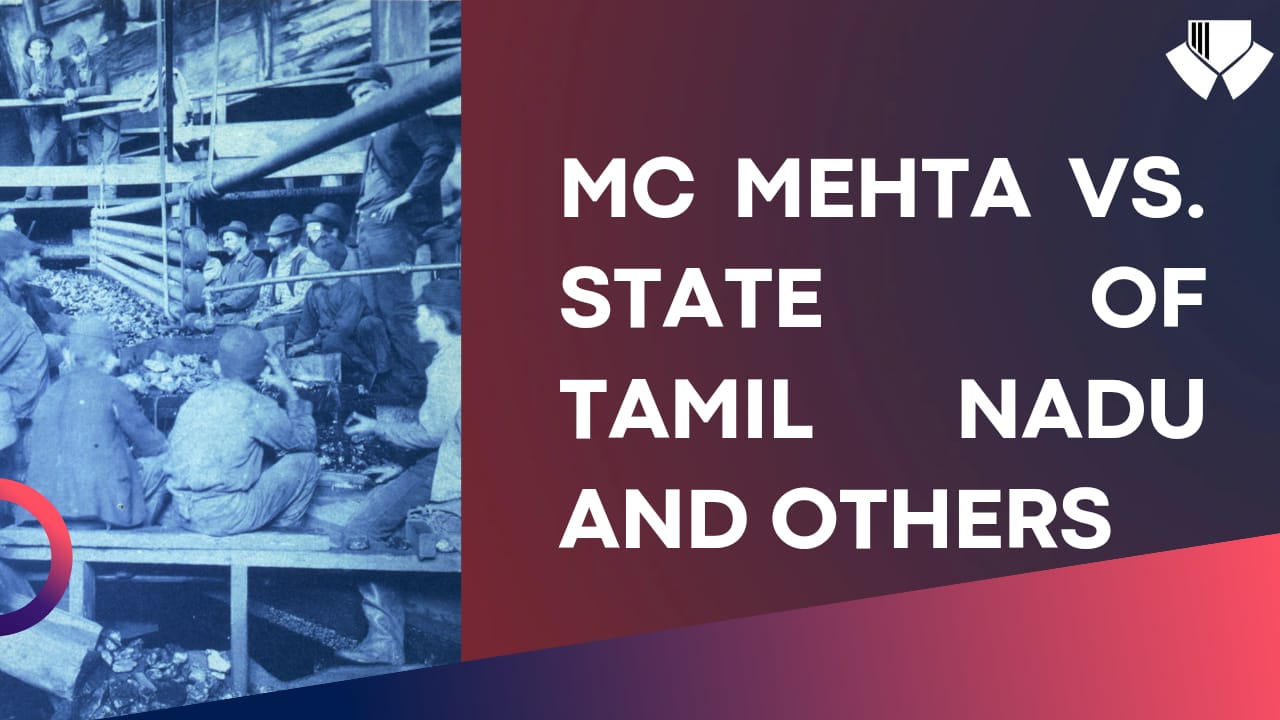This case analysis is written by Samriddhi Sinha, a law student of Brainware University.
Citation: AIR 1997 SC 699
Bench: Justice Kuldip Singh, Justice B.L. Hansaria, and Justice S.B. Majmudar.
Date of Judgement : 10/12/1996
Facts
In this case, child labour in the town of Sivakasi, Tamil Nadu, particularly in hazardous industries like matchstick and firecracker manufacturing, was a pressing issue. M.C. Mehta, a concerned lawyer, filed a petition under Article 32 of the Indian Constitution, contending that child labour in these hazardous industries was morally unacceptable and violated constitutional rights. The Tamil Nadu government did not oppose the claims and proposed solutions.
The court issued directives to improve the welfare of child labourers. Subsequently, after an accident in a fireworks factory in Sivakasi, the court took suo motu cognizance and initiated further action to address safety and labour concerns. This case is significant for its judicial intervention in combating child labour and improving working conditions in Sivakasi, making it a landmark case in the context of child labour laws and child rights in India.
Issues Involved
The issue before the court was to find practical and efficient alternatives to put an end to the employment of children in dangerous and harmful labor. Additionally, the court addressed matters pertaining to the education and overall well-being of children, emphasizing their growth and development.
Contentions of Parties
In this case the contentions of both parties were as follows:
Contention of the Petitioner:
The petitioner, M.C. Mehta argued that it was morally repugnant and unlawful to employ minors in dangerous industries in Sivakasi, Tamil Nadu, notably in the production of matchsticks and firecrackers. He contended that this approach infringed on the fundamental rights of child laborers, such as their right to life and education. According to M.C. Mehta, it is the responsibility of the state to uphold these rights and to guarantee the wellbeing of children.
M.C. Mehta stressed that child labour in such perilous conditions not only deprived children of their childhood but also exposed them to significant health and safety risks. He sought immediate judicial intervention to eradicate child labour in these hazardous industries and to provide these children with opportunities for education and development.
Contention of the Respondent:
The State of Tamil Nadu, representing the respondent side, did not contest the petitioner’s claims. Instead, they acknowledged the seriousness of the issue and expressed their commitment to addressing the problem of child labour in Sivakasi. The state recognized that children’s employment in hazardous industries was a grave concern and indicated their willingness to cooperate in finding a solution.
Rather than presenting a counter-argument, the respondent submitted ideas and proposals to tackle the problem. These proposals included measures to improve the living conditions of child labourers, ensure access to education, and provide avenues for the growth and development of these children. The state aimed to work collaboratively with the court and the petitioner to implement these measures and rectify the situation.
Judgement
The Court held that child labour is not confined to Siva Kasi. The court cited various provisions of the Constitution of India, including Articles 24, 39(e) and 9(f), 41, 47 which protect the social rights of children by prohibiting child labour, see that they are accompanied by free and compulsory education and the provision of honourable standards. Domestic laws like the Apprentice Act, Conditions of Employment for Bidi and Cigar Workers, and Child Labor (Prohibition and Regulation) Act also protected these rights Besides, India adopted the Convention on the Rights of the Child extending protection into the various aspects of a child’s life.
The Court considered the causes of child labour in India, including Nazir Ahmed Shah’s “Child Labor in India”, Dr Amar Singh and Raghuvindar Singh have discussed articles such as “Conventions”, “Trust” etc. on Indian Child Labour” by Dr. J. C. Kulshrestha. The major causes include poverty, retirement age, lack of employment schemes, lack of hydraulic fatigue, child labour, a lack of compulsory education, illiterate parents, and cultural services.
The main reason determined by the court was the deteriorating financial situation of the families, forcing the children to work hard. To remedy this, the court ordered the creation of a welfare fund (called The Fund) for child labour rehabilitation. Anyone who violates child labour laws will have to pay a fine of twenty thousand rupees was donated for the growth of the child.
The court directed the government to ensure that a family member of the child’s household, where the child had been employed in hazardous work, would receive employment. This adult would be responsible for ensuring the child’s full-time education and keeping them away from hazardous labour. However, the court acknowledged that this could potentially burden the state. Therefore, if the government couldn’t employ the adults, they have to contribute five thousand rupees to The Fund for each child employed in hazardous work.
To ensure effective implementation, the court declared that:
- The government must conduct a child labour survey within 6 months.
- Criteria defining hazardous employment areas should be established.
- Employment should be provided to parents or adults in the child’s family.
- If adult can’t be employed , the government must pay eighty five thousand rupees to the child’s parents. If a child isn’t sent for education, the payment will cease.
- High-quality education in reputable institutions should be guaranteed, and inspectors should ensure free education.
Conclusion
In conclusion, this landmark case stands as a pivotal moment in the Indian legal system’s commitment to protecting the rights and welfare of child labourers. The judgment not only addressed the specific issue of child labour in Sivakasi, Tamil Nadu but also recognized it as a pervasive national problem requiring urgent attention.
In essence, the M.C. Mehta case exemplifies the judiciary’s commitment to social justice and the protection of children’s rights in India. It set important legal precedents and provided a comprehensive framework for addressing the complex issue of child labour, serving as a beacon of hope for the eradication of this social evil across the nation.


